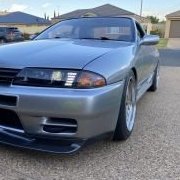-
Posts
1,103 -
Joined
-
Last visited
-
Feedback
100%
White GTS-T's Achievements
-

Why is my rebuilt diff whining?
White GTS-T replied to TurboTapin's topic in Drivetrain and transmission
This might sound like a silly question, but did you put oil in it prior to fitting/driving it? Most places that build gearboxes/diff's/transfer cases etc that I have seen, all come dry, and are not filled with any oil. -

GTR R33 - Removing Rear Propshaft (Front Part)
White GTS-T replied to proline's topic in General Maintenance
Give it a love tap with a soft faced hammer/rubber mallet -
My 32
-
If you're getting CAM/Crank correlation codes, and you've rulled out the sensors and the ECU, then next logical thing left is the wiring, or the mechanical timing of the engine. Can you get an oscilloscope on the CPS and CKP signal wires to rule out timing chain stretch? Can you check the power and ground supply to the VCT solenoids? Are the solenoids actuating? Or, as suggested, are the solenoid gallers blocked or VCT gears worn? What is the service history like on the car? Does the engine rattle when started cold? Find yourself a wiring diagram and test the resistance of the circuits between the sensors and the ECU. Check for mutual shorts, shorts to ground, shorts to power and high resistance. Perform a wiggle test on the wiring loom while monitoring the CKP, CPS, ignition timing etc. What does the scan tool say about the long and short term fuel trims? Does the scan tool log freeze frame/snapshot data when the codes log to help track down and replicate the condition?
- 11 replies
-

Help me not fail at my wheel bearing replacement
White GTS-T replied to PranK's topic in General Automotive Discussion
Hit the end of the puller with a hammer (serious) while it is tight. You'll find once you shock it, you can retention the puller tighter, then repeat the process. -

Balancer Woodruff Key Repair?
White GTS-T replied to CLEM0's topic in RB Series - R31, R32, R33, R34 (1986-2002)
Are people locking the flywheels when torquing these bolts up? Or are they putting the vehicle in gear with the foot on the brake and putting all that torque through the clutch plate? -

qld GTR R32 parts
White GTS-T replied to HBdeebo's topic in For Sale (Private Car Parts and Accessories)
Price for the wheels? -

HKS RB26 Development
White GTS-T replied to White GTS-T's topic in RB Series - R31, R32, R33, R34 (1986-2002)
Yeah, there's nothing really new here, I just thought it was cool to see them throwing everything they had to modernise the RB26. Obviously fuel economy/emissions is one of their main focus points. Perhaps they're going for absolute control over injection timing, or even staging the injection with the twin injector setup? Having twin VCT eliminates the need for EGR when you as you can simply introduce more overlap to perform the same job. Interesting nonetheless. -
So I thought the recent developments from HKS around the RB26 at the TAS for 2022 might be an interesting topic of discussion. For those that haven't seen it, this write-up on Speedhunters explains some of the points of difference with some detailed photos to boot. Here's the article in question; HKS RB26 TAS2022 It looks to include twin VCT, a newly designed twin-chamber plenum, and electronic internal wastegates and recirculation valves, just to name a few.
-
The whole power steering pump pivots. You have to loosen the pump to bracket mounting bolts and then you can move the pump to loosen/tighten the belt











